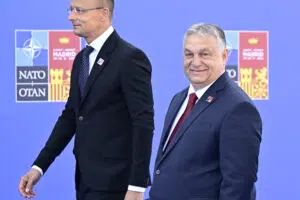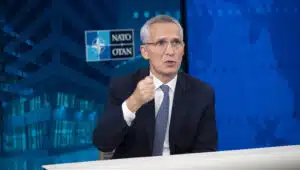Brussels – The last hurdle in front of Sweden’s path into NATO has also fallen. Hungary’s National Assembly has voted today (Feb. 26) in favour of ratifying Stockholm’s accession protocol to the North Atlantic Treaty Organization, and, in a few days, the Scandinavian country will be able to officially become the 32nd member country of the Atlantic Alliance. “Today is a historic day,” rejoiced Swedish Prime Minister, Ulf Kristersson: “We are ready to assume our responsibilities for Euro-Atlantic security.”

The go-ahead came with 188 votes in favour and six against after it had been clear from the words of the prime minister, Viktor Orbán, at the opening of the parliamentary session, that deputies from the ruling Fidesz party would no longer create problems for ratification. The two premiers had met last Friday (Feb. 23) in Budapest to discuss defence and security cooperation, and it emerged from the negotiations that Hungary will be able to purchase four new Swedish-made Gripen fighter jets while Stockholm would no longer see obstructionism from Budapest on its path to Atlantic Alliance membership. “Sweden’s entry into NATO will strengthen Hungary’s security,” Orbán commented today, calling Kristersson’s visit to the Hungarian capital an essential step toward building “a fair and respectful relationship between the two countries.” Sweden’s (and Finland’s 31st member country as of Apr. 4, 2023) accession protocol was signed on Jul. 5, 2022, after a strategic historical turn on national security policy traditionally linked to non-alignment, and it has been an uphill road for Stockholm ever since. More than 19 months after the Madrid Summit, Hungary had remained the only member country not to formally approve Stockholm’s entry into the Atlantic Alliance, when also Turkey ended its tough blockade. A month ago, Orbán had formally dropped his short obstructionism, but so did not his Fidesz party, boycotting the extraordinary session earlier this month. Finding himself under pressure from the other members and cornered by Kristersson’s visit, the Hungarian premier finally pushed his party members to drop the resistance. Secretary General of the Alliance Jens Stoltenberg welcomed “the Hungarian parliament’s vote to ratify Sweden’s membership in NATO. Now that all Allies have approved, Sweden will become the 32nd NATO Ally. Sweden’s membership will make us all stronger and safer.”
The entrance ceremony for the new Alliance member could be held at NATO headquarters as early as Friday (Mar. 1).
Sweden’s steps to join NATO
To become a member of NATO, a country must send a formal application previously approved by its national parliament. This opens two stages of discussions with the Alliance, which do not necessarily pave the way for membership: the first, the Intensified Dialogue, delves into the country’s rationale for applying; the second, the Membership Action Plan, prepares the potential candidate to meet the necessary political, economic, military and legal requirements (democratic system, market economy, respect for the rule of law and fundamental rights, standards of intelligence and contribution to military operations, aptitude for peaceful conflict resolution). This second round of discussions was introduced in 1999 after the accession of Poland, Hungary, and the Czech Republic to address the process with would-be members with political systems other than those of the Alliance’s founding countries, such as the former Soviet countries.

The accession procedure formally begins with the application of Article 10 of the North Atlantic Treaty, which provides that “the parties may, by unanimous agreement, invite for accession any other European state capable of furthering the development of the principles of this Treaty and contributing to the security of the North Atlantic region.” The resolution must be voted on unanimously by all member countries. At this point, the accession talks open at the headquarters in Brussels to confirm the candidate’s willingness and ability to meet the obligations of membership: political and military issues first, security and economic issues second. After the accession talks, which are, in effect, a phase of negotiations, the candidate country’s foreign minister sends a letter of intent to the Alliance secretary general.
The accession process ends with the Protocol of Accession, which is prepared by an amendment to the Washington Treaty, the founding text of the Alliance. This Protocol must be ratified by all members, with procedures varying by country: in Italy, the vote of the Parliament in a joint session is required to authorize the President of the Republic to ratify the international treaty. Once the Accession Protocol has been amended, the NATO Secretary General formally invites the candidate country to join the Alliance, and the agreement is deposited at the U.S. State Department headquarters in Washington. At the end of this process, the candidate is officially a member of the North Atlantic Treaty Organization member.
English version by the Translation Service of Withub






